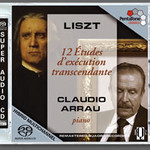
12 Etudes D'Execution Transcendente
 $40.00
Out of Stock
$40.00
Out of Stock6+ weeks add to cart
LISZT
12 Etudes D'Execution Transcendente
Claudio Arrau (piano)
[ Pentatone SACD / Hybrid SACD ]
Release Date: Tuesday 25 March 2008
This item is currently out of stock. It may take 6 or more weeks to obtain from when you place your order as this is a specialist product.
The Études d'exécution transcendante presented in this interpretation by Claudio Arrau are their third and final version from 1851.
Hybrid/SACD - playable on all compact disc players
He was a Czerny pupil, he travelled in elegant coaches across Europe and, as the greatest piano virtuoso of his time, he impressed not only the ruling houses in Russia but the Pope, the high nobility and the middle class concert public. He deliberately left behind his evening gloves on the grand piano that he had just so masterfully handled and preened himself that he was more successful than King Ludwig the first of Bavaria in his courting of the lovely Lola Montez. And with this he affronted his numerous fans who even saved the cigarette buts he threw away or who bought the snuffboxes adorned with his likeness. Every merchandising or brand manager today would have been overjoyed with him - with Franz Liszt. So Liszt was branded a show star, a wag, a self promoter - an image which he happily encouraged.
But this shallowness (although encouraged by Liszt himself) hid a person who, together with his keyboard virtuosity, worked to the highest level as composer, conductor and music theoretician. At that time Liszt´s keyboard technique was unique. He has influenced the playing technique well into the twentieth century, not least with an individual school who´s great grandchildren we can still admire in concert halls today. The enormous demands that he made on playing were not just merely for outward self-aggrandisement but served a higher musical end.
A meeting with Niccolò Paganini the "diabolical violinist" was a crucial experience for the young Liszt. One which he emphatically described as "What a person, what an artist, what suffering from these four strings! His expression, his way of phrasing and - his soul!" What is interesting about this quote is that Liszt didn´t mention Paganini´s technical skills at all but praised the resulting expressive diversity. And he goes one step further in that piano playing should also enter undreamed of spheres: He wanted to transcribe Paganini´s virtuosity for the piano. He developed exercises which for others were unplayable and which demanded that the quickest runs, the most absurd arpeggios and the wildest jumps contained a musical meaning. With him the piano became an orchestra. Not withstanding all the mechanical artistry that per se is part of the virtuoso in Liszt´s piano works can be found a noticeable humanity which both moves and is moving: "For me my piano is what a frigate is for the seaman or a horse to the Arab - more though - my language, my life".
The Études d'exécution transcendante presented in this interpretation by Claudio Arrau are their third and final version from 1851. Liszt was already busy with this work as a fifteen year old boy. At that time he had planned 48 etudes in all major and minor keys. A second version was dedicated to Czerny and in another edition to his friend Chopin. It was published in 1839. Here highly virtuoso elements are already noticeable. The final version focussed even more on a musical value. In the Études d'exécution transcendante one can study Liszt's "mania for revision" which, simular to Bruckner, didn't only have a biographical background. It also had to do with the artistic development of the composer. In the end Liszt wanted to open up new musical directions.
Each of the twelve etudes enables the pianist to present the audience with his mature and impressive technique. But one can not succeed in these character pieces with technique alone. Only those who scratch below the virtuoso surface and integrate the ornamentation into the musical flow, can grasp the spirit of the pieces and serve the musical idea. Usually etudes deal with specific technical problems but these "practice pieces" are considerably more - they are symphonic compositions with their own poetic ideas. No.4 (Mazeppa) is based on a poem by Victor Hugo.The piano paints with orchestral gesture the fate of Mazeppa, a Cossack captain. The "Feux follets" are a flickering mixture of sound and colour. The "Wilde Jagd" rushes past in a ghostly tempo and the "Ricordanza" points in the direction of a future narrative style of Franz Werfel. In "Harmonies du soir" one can see how far into the musical future Liszt already thought in 1851. One can hear sounds that would do justice to Debussy - pure impressionism. The "Eroica", with its dramatic march rhythm as well as its similar thematic relationship to Beethoven's third and fifth symphonies, adds to the pompous "Vision".
Tracks:
12 Études d'exécution transcendante
1 Prélude (Presto)
2 Molto vivace
3 Paysage (Poco adagio)
4 Mazeppa (Presto)
5 Feux follets (Allegretto)
6 Vision (Lento)
7 Eroica (Allegro)
8 Wilde Jagd (Presto furioso)
9 Ricordanza (Andantino)
10 Allegro agitato molto
11 Harmonies du soir (Andantino)
12 Chasse neige (Andante con moto)

